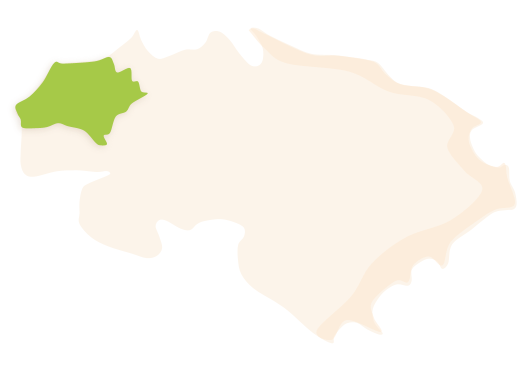La Vall de Gallinera is a beautiful valley nestled between the mountain ranges known as La Foradada and L’Almirant. It is one of the four valleys of Les Valls de La Marina and is made up of 8 villages: Benirrama, Benialí, Benissivà, Benitaia, La Carroja, Alpatró, Llombai and Benissili. It is located in the northwestern part of the region, bordering with the neighbouring counties of La Safor and El Comtat. Standing at 295 metres above sea level, it has one of the lowest population densities in the region due to its area of 53.64 km² and a population of 557, who are known as Vallers and Valleres.
 La Vall de Gallinera's municipal district. Surface area: 53.64 km². Population: 557 (INE data 2021).
La Vall de Gallinera's municipal district. Surface area: 53.64 km². Population: 557 (INE data 2021).HISTORY
La Vall de Gallinera is a natural valley nestled between two mountain ranges (Serra de L'Almirant to the north and Serra Foradada to the south), with the River Gallinera running through its centre. All along the valley there are springs where the shady area known as L’Ombria drains into the river, from the slopes of La Foradada on the southern bank, where all the villages and the most characteristic crops are concentrated, such as the cherry trees. Meanwhile, on the south-facing slopes of La Solana is where all the livestock corrals are concentrated.
La Vall de Gallinera has been inhabited since ancient times, as shown by the more than 18 rock shelters with walls full of prehistoric paintings, located near the River Gallinera. The earliest signs of human presence that have been discovered in the valley date back to the Middle Paleolithic, with the presence of Neanderthals in the northeastern area of La Vall de Gallinera. As for the Neolithic period, the rock paintings of Levantine art (schematic and macro-schematic) are noteworthy and some of them can be visited, such as those close to Benirrama and those near to Benialí. The Bronze Age and the Iberian period also have their archeological sites located in the higher parts of the valley, of which the Xarpolar settlement from the ancient Iberian period stands out.
However, the main characteristics and morphology of La Vall de Gallinera are entirely from the Andalusian period. The first advances made by Al-Andalus occurred during the 10th century, settling on the Almiserà high point with an Umayyad fort. Little by little, various farms based on clans or families were built on the lower slopes of La Foradà: Benalcatim, Benialí, Benifetef, Benimàmit, Benimahomet, Benimarsoc, La Solana, Benitaia, Benitalaf, Bolcassim, Alpatró, L'Alcúdia, La Carroja, Benissivà, Ràfol, Benistrop, Llombai, Benirrama, Beninbader and Benissili. These were guarded to the north by the castle of Alcalà, currently popularly known as the castle of Benissili, and to the south by Gallinera Castle (popularly known nowadays as the castle of Benirrama) which gave its name to the entire valley.
With the arrival of the Christians, La Vall de Gallinera remained a fully Muslim valley despite having been the headquarters of the revolts led by Al-Azraq and clearly a nucleus of Mudejar resistance. This was the case until the Moorish expulsion decree of 1609. Repopulation came with the settlement charter signed in Benialí on the 11th of June 11, 1611, with the presence of 78 Majorcan families. Cavanilles mentioned that the valley was inhabited by 150 Majorcan families. In fact, Alemany, Puig, Seguí, Cortell and Palmer are just some of the surnames commonly found within the valley, denoting this island heritage.
La Foradada is one of the most visited places in La Vall de Gallinera, which is reached following paths that permit observation of many different natural areas, also allowing for an overall vision of the agricultural and livestock heritage of the 17th and 18th centuries, with dry stone terraced fields, wheat threshing floors, livestock pens and traditional cobbled paths for transport with animals or for moving herds.
FESTIVITIES
- Festes de Benirrama: the festivities of this village are held during the last weekend of July.
- Festes de Benissivà: the celebrations of this village take place during the first weekend of August, in honour of Saint Roc.
- Festes de Benialí: this village’s festivities are celebrated during the second weekend of August, in honour Saint Miquel and La Mare de Déu dels Desemparats (Moros i Cristians).
- Festes d’Alpatró: the festivities of this village are held between the 14th and the 18th of August.
- Festes de La Carroja: these celebrations take place in La Carroja during the third weekend of August, in honour of Saint Francesc de Borja.
- Festes de Benissili: the festivities of Benissili are held during the last weekend of August, in honour of Saint Pasqual Bailón.
- Festa de La Cirera (The Cherry Festival), held during the second weekend of June.
- Fira de L’Oli, or The Olive Oil Festival.
- The sun alignment takes place on the 9th of March and on the 4th of October.
GASTRONOMY
- The whole wheat and vegetable stew known as “blat picat”.
- ”Minxos” (a cross between a corn flour flatbread and a pancake).
- ”Arròs al Forn”, a typical local baked rice dish.
- Dishes with wild boar.
- Cherries.